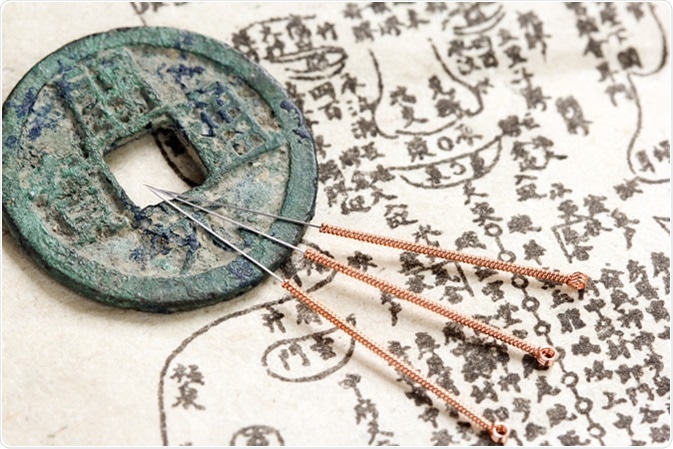The theory and practice of acupuncture originated in China, where it was first mentioned and recorded in writing several hundred years before Christ.
Around 6000 BCE, sharpened stones or long, sharp bones were used instead of needles for acupuncture, and these instruments may have also been used for minor surgical procedures such as opening abscesses.

Acupuncture and ancient medical illustration showing pressure points on the human body – Image credit: Pixeljoy / Shutterstock
Documented acupuncture procedure records
A document sealed in the Mawangdai Tomb in China in 198 BC makes no mention of acupuncture procedures, but does mention the meridian system.
Discovery of the Two Tombs of King Ma
In the traditional acupuncture theory, it is believed that there is an energy flowing through the human body, and that by controlling this energy flow, balance and health can be achieved. This energy flow is called “chi”, pronounced “chee”.
In acupuncture theory, this chi is believed to travel throughout the body along 12 major pathways called meridians. These meridians represent the major organs and functions of the body, although they do not follow the exact pathways of nerves or blood flow.
Additionally, the tattoo marks found on Ötzi the “Ice Man,” who died around 3300 B.C., resemble some kind of stimulation therapy related to the meridians. The Ice Man was discovered when the glaciers in the Alps melted.

Ötzi had a total of 61 tattoos, consisting of 19 pairs of black lines, ranging from 1 to 3 mm in thickness and 7 to 40 mm in length.
The oldest documented reference to the acupuncture procedure is The Yellow Emperor’s Inner CanonA book on meridians from about 100 BCE. In this book, knowledge is given in the form of questions from the emperor and the answers given by his learned minister, Zhibo. This book contains detailed knowledge on the concept of meridians (channels or conduits through which qi flows), although the exact location of the acupuncture points was not revealed until much later.
The development of acupuncture
Acupuncture developed over the next few centuries and gradually became one of the standard treatments used in China. Acupuncture was complemented and supported by the use of massage, dietary therapy, herbs, heat therapy, and moxibustion.
It was in the 15th century that bronze statues with acupuncture points that are still used today were painted. They were used for teaching and examination purposes.
The Ming Dynasty (1368-1644) flourished from the 14th to the 16th centuries. Complete guide to acupuncture and moxibustion This book summarises the principles of acupuncture that underpin the modern practice of this tradition.The book describes 365 points that represent openings in the channels through which needles can be inserted to redirect the flow of chi.
The decline of acupuncture
After the 17th century, interest in the tradition waned, as acupuncture was considered irrational and superstitious, and in 1822 an imperial decree excluded acupuncture from the Imperial Medical Institute. Local healers and some scholars held on to their knowledge of acupuncture.
With the rise of Western medicine in the 20th century, acupuncture’s reputation fell further and in 1929 it was banned in China along with other traditional medicines.
The revival of acupuncture
In 1949, the Communist government revived traditional medicine, including acupuncture. By the 1950s, acupuncture research institutes were established throughout China and acupuncture became available in some hospitals.
The practice spread to several other countries. Korea and Japan received the knowledge in the 6th century. Ten Rhein, a European physician working for the East India Company, described the practice medically around 1680. In the early 19th century, both America and England became interested in this ancient healing method.
In 1971, a US journalist visiting China underwent acupuncture treatment after an emergency appendectomy. He wrote about his experience in The New York Times, sparking interest in the success of the treatment..
Acupuncture has finally been accepted in the United States after an NIH consensus conference reported that there is positive evidence of its effectiveness, at least for some conditions.

